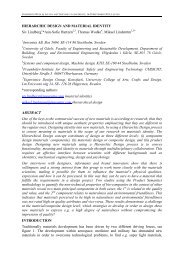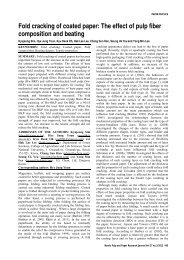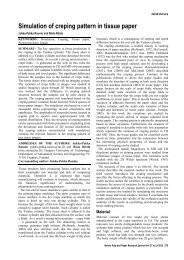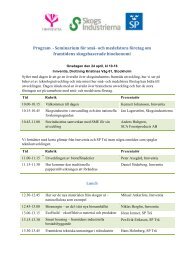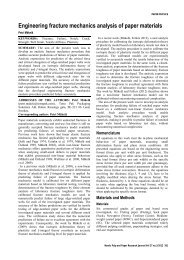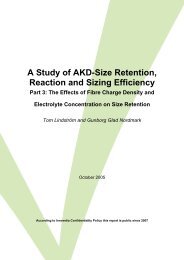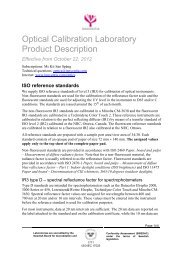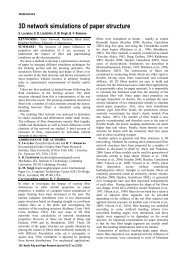Stress-strain curve of paper revisited - Innventia.com
Stress-strain curve of paper revisited - Innventia.com
Stress-strain curve of paper revisited - Innventia.com
Create successful ePaper yourself
Turn your PDF publications into a flip-book with our unique Google optimized e-Paper software.
PAPER PHYSICS<br />
fibers. Plasticity on the fiber level reduced the <strong>strain</strong><br />
variations since the energy dissipated through plastic<br />
deformations in the areas <strong>of</strong> high <strong>strain</strong>.<br />
The influence <strong>of</strong> the bond strength was significant. A factor<br />
<strong>of</strong> 2-3 in bond strength, which is relatively low in the view <strong>of</strong><br />
the scatter encountered throughout the literature, changed<br />
the strength <strong>of</strong> the network dramatically. At the same time, a<br />
"non-traditional" bonding parameter, namely, the<br />
<strong>com</strong>pliance <strong>of</strong> the bond regions showed a <strong>com</strong>parably strong<br />
effect on the strength as the bond strength. More <strong>com</strong>pliant<br />
bond regions increase the strength by accumulating more<br />
energy prior to failure. This suggests that the critical fracture<br />
energy, which account for both the strength and <strong>com</strong>pliance<br />
<strong>of</strong> the bonds, is a better measure for relating bond and<br />
network strength. The work <strong>of</strong> separation (another<br />
unconventional bonding property) showed a relatively small<br />
impact on the stress-<strong>strain</strong> <strong>curve</strong> and can be discarded in<br />
practical applications.<br />
Decreasing the number <strong>of</strong> bonds in the network by 50%,<br />
did not change the elastic stiffness significantly but<br />
decreased the strength. It also increased stress variation<br />
inside the network as well as the mean axial stress in the<br />
load-bearing fiber segments.<br />
Acknowledgement<br />
The authors appreciate WoodWisdom-NET and BiMaC Innovation<br />
together with their industrial partners for the financial support.<br />
Literature<br />
Alava, M. and Niskanen, K. (2006): The physics <strong>of</strong> <strong>paper</strong>, Reports<br />
on Progress in Physics 69(3), 669-723.<br />
Aulin, C., Gällstedt, M. and Lindström, T. (2010): Oxygen and oil<br />
barrier properties <strong>of</strong> micr<strong>of</strong>ibrillated cellulose films and coatings,<br />
Cellulose 17(3), 559-574.<br />
Batchelor, W. (2010): Application <strong>of</strong> an analitical method to<br />
calculate the load distribution along a fibre in a loaded fibre<br />
network, Appita Journal 63(4), 287-293.<br />
Gradin, P., Graham, D., Nygård, P. and Vallen, H. (2008): The<br />
Use <strong>of</strong> Acoustic Emission Monitoring to Rank Paper Materials with<br />
Respect to Their Fracture Toughness, Experimental Mechanics<br />
48(1), 133-137.<br />
Groom, L., Mott, L. and Shaler, S. (2002): Mechanical properties<br />
<strong>of</strong> individual southern pine fibres. Part I. Determination and<br />
variability <strong>of</strong> stress-<strong>strain</strong> <strong>curve</strong>s with respect to tree height and<br />
juvenility, Wood and Fibre Science 34(1), 14-27.<br />
Henriksson, M., Berglund, L. A., Isaksson, P., Lindström, T.<br />
and Nishino, T. (2008): Cellulose Nano<strong>paper</strong> Structures <strong>of</strong> High<br />
Toughness, Biomacromolecules 9(6), 1579-1585.<br />
Heyden, S. (2000): Network Modelling for the Evaluation <strong>of</strong><br />
Mechanical Properties <strong>of</strong> Cellulose Fluff, Lund University, Lund.<br />
Hägglund, R. and Isaksson, P. (2008): On the coupling between<br />
macroscopic material degradation and interfiber bond fracture in an<br />
idealized fiber network, International journal <strong>of</strong> solids and<br />
structures 45, 868-878.<br />
Joshi, K., Batchelor, W., Parker, I., Nguyen, L. (2007): A new<br />
method for shear bond strength measurement, International Paper<br />
Physics conference, Queensland, Australia, pp. 7-13.<br />
Kulachenko, A. and Uesaka, T. (2010): Simulation <strong>of</strong> Wet Fiber<br />
Network Deformation, Progress in Paper Physics, Montreal,<br />
Canada.<br />
Lindström, T., Wågberg, L., Larsson, T. (2005): On the nature<br />
Advances in Paper Science and Technology, Cambridge, The Pulp<br />
and Paper Fundamental Research Society, pp. 457-562.<br />
Niskanen, K. (1998): Paper Physics, Fapet Oy.<br />
Niskanen, K. J., Alava, M.J., Seppäla, E.T., Åström, J. (1999):<br />
Fracture Energy in Fibre and Bond Failure, Journal <strong>of</strong> Pulp and<br />
Paper Scince 25(5), 167-169.<br />
Page, D. H. and El-Hosseiny, F. (1983): The mechanical<br />
properties <strong>of</strong> single wood pulp fibers. Part IV. Fibril angle and the<br />
shape <strong>of</strong> the stress-<strong>strain</strong> <strong>curve</strong>, Journal <strong>of</strong> Pulp and Paper 9(4),<br />
99-100.<br />
Retulainen, E., Ebeling, K. (1993): Fibre-fibre bonding and ways<br />
<strong>of</strong> characterizing bond strength, Appita Journal 46(4), 282-288.<br />
Räisänen, V. I., Alava, M. J., Nieminen, R. M. and Niskanen, K.<br />
J. (1996): Elastic-plastic behaviour in fibre networks, Nordic Pulp<br />
and Paper Research Journal 11(4), 243-248.<br />
Seth, R. S. and Page, D. H. (1983): The <strong>Stress</strong> Strain Curve <strong>of</strong><br />
Paper, The Role <strong>of</strong> Fundamental Research in Paper Making,<br />
Mechanical Engineering Publication, London, pp. 421-452.<br />
Zavarise, G. and Wriggers, P. (2000): Contact with friction<br />
between beams in 3-D space, International Journal for Numerical<br />
Methods in Engineering 49, 977-1006.<br />
328 Nordic Pulp and Paper Research Journal Vol 27 no.2/2012



